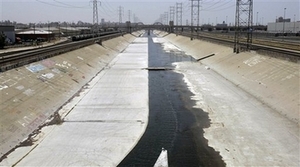Barring a surprise arrival of the kind of gully washers Texas is getting these days, Los Angeles' driest year in 130 years of record-keeping will go into the books this weekend.
The nation's second-largest city is missing nearly a foot of rain for the year counted from July 1 to June 30. Just 3.21 inches have fallen downtown in those 12 months, closer to Death Valley's numbers than the normal average of 15.14 inches.

|
| ©AP
|
| A very shallow Los Angeles riverbed is shown Friday June 29, 2007. Californians are canceling July 4 fireworks because drought raised the risk of fire. And Texans could have their displays drowned out by
|
And it's much the same all over the West, from the measly snow pack and fire-scarred Lake Tahoe in the Sierra Nevada to Arizona's shrinking Lake Powell and the withering Colorado River watershed.
The weather that's withering Los Angeles and drowning Texas are connected, said Bill Patzert, a Jet Propulsion Laboratory scientist who researches the ocean's role in climate variations and has watched a Western drought grow for seven years.
Stationary high pressure has pushed the moisture-bringing jet stream to the north, which has also allowed moist air to linger over Texas, he said.
"This last year it's definitely like the nail in the coffin," Patzert said of California's drought. "This is where the pain really comes home. One of these droughts - you kind of creep into it slowly - and it then takes a long time to get out of it."
Los Angeles has already called for a voluntary 10 percent cut in water use, and in recent months its Fire Department has faced wildfires more typical of fall, including one that left its vast Griffith Park glowing like a giant barbecue in the middle of the city.
In suburban Pasadena, firefighters recently sprayed fire retardant in brushy areas around the Rose Bowl, which hosts an annual Fourth of July fireworks show.
"At this point I don't know why every city in Southern California is not banning fireworks for the Fourth of July, because we have never been this dry this early," Patzert said.
Los Angeles could escape the record if sometime in the last hours of Saturday it gets a dose of Texas weather.
The Lone Star state has had one of its wettest springs after back-to-back years of record drought. As of Friday morning, 10.97 inches of rain had fallen for the month at Dallas-Fort Worth International Airport. That's only a half-inch short of what fell in June 1928, the rainiest month on record.
The weather extremes have a common thread, Patzert said: the jet stream.
"Although we had a lot of storms in the Gulf of Alaska this winter, we had just a big, stationary high-pressure system either offshore or to the east of us, and really what it did was it just drove that rain-delivery jet stream into the Pacific Northwest and just totally bypassed us," he said.
The circulation of high pressure also tends to cause Southern California's Santa Anas, the dry, warm winds that descend out of the high desert north of Los Angeles and are often linked to terrible fires in fall and winter. In the past year there have been three times the normal number of Santa Ana days, Patzert said, and a "more or less continuous fire season."
"The devil winds gave us the diva of drought," he said.
The shift in the jet stream to the north has also kept rain over Texas, he said.
"Usually the jet stream tends to move these things along," he said.
Last year was Texas' driest ever, with more than $4.1 billion in crop and livestock losses and deadly wildfires that ravaged a record 2 million acres. But many praying for rain a year ago now are screaming, "Enough!"The central Texas cities of Austin and San Antonio have received nearly twice as much rain as usual for June. And earlier this week, about 18 inches of rain fell overnight near Marble Falls, about 40 miles northwest of Austin. Boats and helicopters rescued people who scrambled atop buildings and vehicles.
Even typically parched west Texas is getting drenched. So far this year, Lubbock had received 17.39 inches of rain - just over an inch shy of the amount it usually gets during the entire year.
"It's pretty rare to see that much rainfall in a half year, but it's been happening across Texas." Mark Conder, a meteorologist with the National Weather Service in Lubbock.
The Jet Propulsion Laboratory's Patzert, who is best known for explaining the ocean warming and cooling phenomena known as El Nino and La Nina, said such deluges do little to recharge aquifers because the water runs off too quickly, compared with the slow melting of snow packs.
In California, he said, the drought situation resembles the 1950s and '60s rather than the unusually wet '80s and '90s, and it's not going away.
"I think last year, unfortunately, people should plan on that as a preview of coming attractions, because there are no big patterns in the Pacific that are rainmakers," he said. "There's no El Nino galloping over the horizon to save us here."
___
Associated Press writer Jeff Carlton in Dallas contributed to this report.
Reader Comments
to our Newsletter